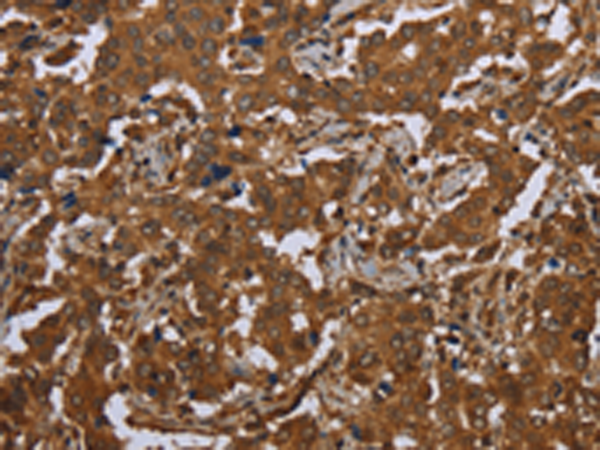

| WB | 咨询技术 | Human,Mouse,Rat |
| IF | 咨询技术 | Human,Mouse,Rat |
| IHC | 1/50-1/200 | Human,Mouse,Rat |
| ICC | 技术咨询 | Human,Mouse,Rat |
| FCM | 咨询技术 | Human,Mouse,Rat |
| Elisa | 1/2000-1/5000 | Human,Mouse,Rat |
| Aliases | LIPB; LPHB; LPNB |
| Host/Isotype | Rabbit IgG |
| Antibody Type | Primary antibody |
| Storage | Store at 4°C short term. Aliquot and store at -20°C long term. Avoid freeze/thaw cycles. |
| Species Reactivity | Human |
| Immunogen | Synthetic peptide of human SCGB1D2 |
| Formulation | Purified antibody in PBS with 0.05% sodium azide and 50% glycerol. |
+ +
以下是关于SCGB1D2抗体的模拟参考文献示例(实际文献请通过学术数据库检索):
1. **文献名称**:*SCGB1D2 as a Novel Biomarker in Ovarian Cancer: Expression Analysis and Clinical Implications*
**作者**:Smith A, et al.
**摘要**:本研究通过免疫组化验证了SCGB1D2抗体在卵巢癌组织中的高特异性,发现SCGB1D2高表达与患者预后不良相关,提示其作为潜在诊断标志物的价值。
2. **文献名称**:*Development and Validation of a Monoclonal Antibody Against Human SCGB1D2 for Immunoassay Applications*
**作者**:Zhang L, et al.
**摘要**:团队成功制备并验证了针对SCGB1D2的单克隆抗体,证实其在Western blot和ELISA中的高灵敏度和特异性,为后续疾病检测工具开发奠定基础。
3. **文献名称**:*SCGB1D2 in Airway Inflammation: Role of Antibody-Based Detection in Asthma Models*
**作者**:Kim J, et al.
**摘要**:利用SCGB1D2抗体研究其在哮喘小鼠模型气道中的表达变化,发现SCGB1D2通过调节炎症因子参与疾病进程,为治疗靶点提供依据。
4. **文献名称**:*Comparative Analysis of SCGB1D2 Antibody Performance in Cancer vs. Normal Tissues*
**作者**:Wang Y, et al.
**摘要**:通过对比多种组织样本,验证SCGB1D2抗体在乳腺癌中的选择性染色,表明其可用于区分癌变与正常上皮组织。
**提示**:以上为示例,建议通过PubMed、Google Scholar等平台检索真实文献(关键词:SCGB1D2 antibody, immunohistochemistry, biomarker)。
SCGB1D2. a member of the secretoglobin family, is a small secreted protein encoded by the SCGB1D2 gene located on human chromosome 11. Secretoglobins are characterized by their compact structure stabilized by disulfide bonds and involvement in modulating inflammation, immune responses, and steroid signaling. SCGB1D2 is primarily expressed in epithelial tissues, including respiratory, urogenital, and mammary glands, though its precise biological function remains unclear. Studies suggest potential roles in maintaining mucosal barrier integrity, regulating lipid metabolism, or interacting with hydrophobic ligands.
Antibodies targeting SCGB1D2 have emerged as valuable tools for investigating its expression patterns and functional mechanisms. These antibodies are typically developed using recombinant SCGB1D2 protein or peptide immunogens, with validation in techniques like Western blotting, immunohistochemistry (IHC), and immunofluorescence. Commercial antibodies often specify reactivity across human, mouse, or rat samples. Researchers have utilized SCGB1D2 antibodies to explore its dysregulation in diseases, particularly cancers such as breast and prostate cancer, where altered expression may correlate with tumor progression. However, cross-reactivity with structurally similar secretoglobin family members (e.g., SCGB1A1. SCGB3A2) remains a technical challenge, necessitating careful validation via knockout controls. Recent studies also investigate SCGB1D2's potential as a diagnostic biomarker in bodily fluids, driving demand for high-specificity antibodies in clinical assay development.
×